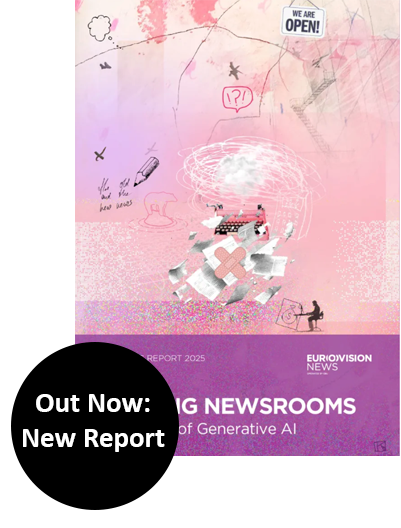Journalism is serious business. Just recently, a Greek investigative reporter was shot dead outside his home in a suburb of Athens. Even in Germany journalists are increasingly being physically attacked, which is why Reporters Beyond Borders downgraded the country’s state of press freedom from “good” to “satisfactory” in its latest report. Especially in Central and Eastern Europe, politicians and oligarchs are cornering independent media. And then German comedian Jan Böhmermann came along and landed a newsstand, TV and social media hit with a satirical magazine, “Freizeit Magazin Royale”, poking fun of German publishers. What got young people most worked up? Guess: that Böhmermann’s magazine was out of print after a few days.
One should still not deny young audiences a sense of seriousness too easily. Humor is a serious matter, and it doesn’t take attacks on caricaturists to get this. The trend of young people increasingly approaching the news through comedy has been showing for a while. A study in the journal Journalism highlighted this in the U.S. as early as 2007, a decade after the launch of “The Daily Show” on Comedy Central. Since then, corresponding formats have been developed in many places. Modern newsrooms better get down to this soon: Mastering lighter formats is the key to getting the next generation excited about news. This is easier written than done though.
Satire is one of the journalistic genres that fails most often. What is satire, what is just bad taste and what is even inhumane? This was the subject of a heated debate in Germany just under a year ago, when a not-so-funny column by Hengameh Yaghoobifarah in the taz newspaper equated the police with garbage and therefore caused a lot of concern – right up to the Federal Minister of the Interior and the German Press Council. Even more than other forms of journalism, which can be mastered acceptably with craft, persistence and a lot of practice, satire requires a certain talent – in other words, humor. To make matters worse, this is even culturally coded.
Not everyone can and should laugh at everything. Humor exerts power, and therefore tends to work better from bottom up. There is a huge difference between rebelling against established power structures and cementing them by joking from above. For this reason, a show in which privileged presenters amuse themselves about political correctness is very prone to go wrong. This happened famously with the failed #allesdichtmachen campaign, in which well-known actors supposedly wanted to argue ironically for freedom of expression in the Covid 19 crisis. Too bad that parts of the public perceived this, at best, as whining from the designer kitchen.
American communications scholar Danna Young describes in her 2019 book “Irony and Outrage” that satire involves a certain basic liberal attitude that values freedom of thought and takes a playful approach to serious things in life. The counterpart to this in the right-wing political spectrum is the rise of rage talk shows, she argues.
The traditional media move between these poles. Their journalists work in the facts business and rarely in the humor field. Facts are unambiguous and clear by definition. Humor is ambiguous and lives through interpretation. Mixing things up is dangerous. Especially in social media, humor is often difficult to identify. Moreover, many reporters and commentators rarely feel like laughing (see above), cynicism excluded.
Still, humor works just fine with young audiences. Rule number one: It must not underestimate its addressees. The German (print) magazine Katapult is such a hit with the young generation, because it casually mixes factual depth and lightness. Subtitle: “Magazine for icecream, cartography and social science”, need we explain more? Young users prefer journalism that explains, is useful in their daily lives, and is fun, according to a study published by the Reuters Institute in Oxford.
The fun factor is still limited when consuming most established media. In the past, it was considered proof of belonging to the educated class, if one had to struggle properly while reading the newspaper. Today, status postures only trigger boredom. After all, the more easily digestible alternative is already waiting – on YouTube or Tik Tok. Now, it’s not about replacing news and analysis with satire. If you can’t bring it up to premium quality when it comes to humor, you better leave it. What everyone can work on, however, is tone. Many podcasts work so well because they come across as light and chatty.
Newspapers can still work on it. Some essays exude more enthusiasm of the writers about themselves and their clever sentences rather than mastery of language. To the audience, they only seem embarrassing. Young people in particular have good antennae for jokes being made at the expense of the weak. They don’t perceive it as funny, but as offensive and discriminatory. Lecturing is out, taking seriously is in. When in doubt, it’s okay to make fun of yourself. You don’t even have to be a comedian to do that.
This column appeared in German in the newsletter of the Digital Journalism Fellowship at Hamburg Media School on April 23, 2021. Translated with www.DeepL.com/Translator (free version) and then edited.




MUNICH – When a local radio station in Charlotte, North Carolina started a podcasting competition in its community, it was prepared for many contingencies, except one: that the response would overwhelm the station’s server. The initiative was aimed at increasing on-air diversity, and tens of thousands of people wanted in. Groups and individuals from all walks of life submitted more than 370 ideas for podcasts, and 33,000 listeners logged on to vote for them. What started as a one-time experiment will now be a regular feature.
Journalism has always suffered from a lack of diversity. Demographically uniform newsrooms have been producing uniformly homogeneous content for decades. And while editors around the world have increasingly recognized that this is a problem, too little has been done to address it.
One reason, ironically, is a preoccupation with digital change. “There has been so much focus on digital transformation in recent years, the question of diversity has had to stand aside,” explains Olle Zachrison of the Swedish public broadcaster Sveriges Radio, in a study comparing diversity efforts in the United Kingdom, Sweden, and Germany. And yet, as the newsroom in Charlotte discovered, diversity is not just an added bonus; it is at the very core of audience engagement today.
In explaining the business ethos of the digital age, Amazon founder Jeff Bezos has argued that it is all about “customer obsession as opposed to competitor obsession.” For the media, then, the guiding principle should be “audience first.” And that means using data to understand and cater better to it.
Not long ago, editorial choices were guided mostly by gut feelings and assumptions, whereas now they are often informed by analytical metrics and revealed truths about audience behavior. Some of these revelations are uncomfortable. Editors can no longer fool themselves about their journalism’s real-world impact. They now know that even the best stories tend to reach just a fraction of their hoped-for audience.
Complicating matters further, newsrooms have discovered that demand can peak at times when they have no new offerings, or when what they’re serving is not what consumers are seeking. In surveys like the Digital News Report, respondents often complain that the media offer too much negativity and volume, and too little explanation and relevant coverage.
Before digitalization, journalists didn’t have to think about their audiences as much as they do now. Newspapers were money-printing machines – the advertising dollars poured in regardless of what would now be called “content.” Likewise, public-service media faced almost no competition. But now that digital information is a commodity, with a few major platforms controlling its distribution, audience loyalty has become a matter of survival.
Many newsrooms were entirely unprepared for this new reality. They don’t even know who their potential new customers are, let alone how to reach them and win their trust. The problem is not just that newsroom homogeneity results in an incomplete view of the world and of the reading/listening public. It is that even when “outsiders” do land a job in this kind of environment, they tend to adapt to the dominant culture rather than challenge it. As a result, newsrooms remain ill equipped to reach out to new audiences.
The lack of diversity in the media has actually worsened in recent decades. Back in the heyday of local news, newsrooms were no less white or male, but being a journalist at least didn’t require a university degree – only a willingness to dive in and chase leads. Yet as the industry became concentrated more in big cities and employment prospects elsewhere diminished, education became yet another entry barrier. While the better-educated candidates moved up to higher-profile jobs, many others left the profession altogether.
In keeping with the industrial society of the time, the occupational model that followed from these changes was hierarchical. As with teachers and their pupils, preachers and their congregations, and experts and the lay public, education conferred status and authority upon journalists. The public was a passive recipient of information, not an engaged participant in a broader conversation.
Clinging to this hierarchical structure is now a recipe for failure. The digital world of information is one of choice and abundance, but also of considerable confusion about what is true and false. Trust is a news organization’s most valuable asset, and the task for journalists is both to challenge and inspire their audience, and to invite conversations among them.
That can’t happen unless journalism represents the society in which it is operating. Unfortunately, a recent global survey of media leaders finds that while editors see progress toward gender diversity, much more must be done to achieve racial and political diversity, as well as a balance between “urban” and “rural” backgrounds. The most likely reason for this failure is that industry leaders continue to regard the digital transformation as a matter of technology and process, rather than of talent and human capital.
Fortunately, the digital transformation represents an opportunity. As Jeff Jarvis of the City University of New York explains, industry leaders should “Try listening to, valuing, and serving the people and communities who were long ignored and left unserved by our old industry, mass media.” All news organizations should take Jarvis’s advice – and not just because it is the right thing to do. Their own survival depends on it.
This commentary was published in ten languages by Project Syndicate on June 25, 2020